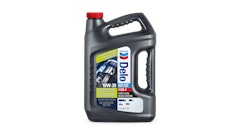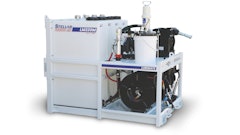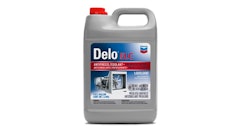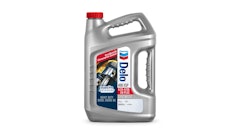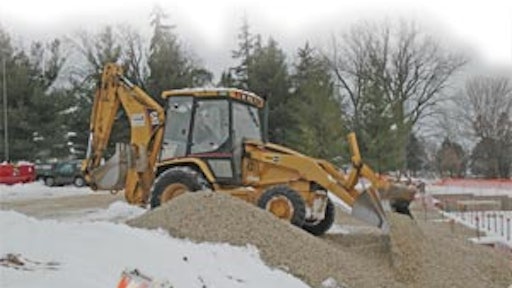
Whether you store equipment over winter or operate in cold climates, fluid maintenance prior to the winter chill can save a lot of headaches. Large temperature fluctuations impact the performance of virtually every fluid in your equipment, and acids built up in used motor oil can damage internal components.
"Contamination and moisture are the bad guys," says Shawn Ewing, technical coordinator, Conoco and 76 Lubricants brands. "They are the ones that usually cause a high percentage of failures."
Examine coolant condition
A good starting point is the cooling system. "Do a complete evaluation of the system. Pressure test it for leaks and check all of the hose clamps," says Dan Arcy, technical marketing manager, Shell. "Make sure all of the hoses are in good shape. The last thing you need to do is break a hose in the middle of the winter."
The fluid itself must also be in good condition. "Check the freeze point of the coolant to ensure it is to the correct ratio per the OEM's recommendations, as well as do a coolant analysis to ensure the coolant is in the proper condition," says Jason Gerig, marketing manager, Chevron Global Lubricants.
You can check the freeze point with coolant test strips. "For best results, test when the coolant is between 50° F to 140° F and dip the strip into the coolant for one second," advises Dave Perry, tech services & product support manager, BP Lubricants USA Inc. "Remove and shake to eliminate excess and read the percent glycol."
Most manufacturers recommend a glycol coolant to water ratio of 50/50. According to Arcy, this gives you a freeze point of -34° F. "You don't have to worry about the wind chill factor," he explains, but rather the absolute ambient temperatures. "Except in some of the Northern parts of Canada, it doesn't really get that cold in the lower 48."
If you do need protection below -34° F, you can slightly increase the glycol concentration to 60/40. "A 60% glycol and 40% water mix will provide a freeze point of -65° F," says Perry. "Glycol contents beyond 70% will actually reverse the freeze point."
This makes it critical to really track the coolant ratio, which can be difficult to do after the system has been topped off a couple of times. "A lot of times with this equipment, you are adding close to a gallon when you are topping up a system," says Arcy.
When you use concentrate, you have to add a 1/2 gal. of concentrate and a 1/2 gal. of water. "People will take a bottle of concentrate and pour it in," says Arcy. "Then they will add water on top of it. They don't actually mix it first. They guesstimate."
This works okay at first, but eventually the ratio gets way out of compliance. "You take a sample in the field and the freeze point is off," says Arcy.
This situation can be avoided. "The best option would be to purchase premixed 50/50," says Gerig. In addition to ensuring the proper ratio is maintained, manufacturers use de-ionized water in the premixed coolants. This is very important to the integrity of the coolant system.
"You want to avoid at all costs adding tap water or any other type of water that is not de-mineralized," says Gerig. "[With tap water] basically you are adding solids to your system, which can cause deposits and premature wear to the water pump."
In addition, the pH level of tap water may not be ideal. "Since the pH of deionized water is a neutral 7, the stability of the antifreeze is assured, guaranteeing optimum cooling system performance," says Perry.
SCA levels in conventional coolants also need to be checked and corrected prior to winter use. This step can be eliminated by using extended-life coolant. "With the extended-life coolant, you don't have to add SCAs," says Arcy. "There are other benefits to the product, as well. Because it has no sulfates in it, you have longer water pump life."
Match viscosity to conditions
With lubricating oil, flow properties are the main concern. "Any lubricating-type oil will be affected by cold weather since at lower temperatures the oil viscosity will increase," says Perry.
Oil flow is critical at startup. "Most of the normal wear occurs at cold startup," says Ewing. "The quicker you can get the oil flow to all of the moving parts, the better off you are."
Mark Betner, heavy-duty product manager at Citgo, agrees, adding, "The better an oil flows in these conditions, the better the wear protection, along with reduced stress on batteries and starters."
Oil flow at a given temperature is determined by the viscosity. "It is important to check with the OEM; typically it provides viscosity recommendations for given operation temperature ranges," says Gerig. "If you are unable to pre-warm the engine prior to a cold start up, using the correct viscosity grade will provide some wear protection."
Lighter viscosity engine oils also increase cold start capabilities. Batteries lose cranking power in cold weather and the oil thickens. "The crankshaft is trying to turn through the oil," says Arcy. "So if you go with a lower viscosity oil, the resistance will be less and it will take less energy for the starter or battery to turn it over. We had one [customer] that reduced the remote starters they were having to use on some of their equipment by switching to a lighter viscosity product."
With multigrade oils, it is particularly important to select the correct grade. "The W associated with multigrade oil can make a difference in cold temperature fluidity and borderline pumping temperature," says Betner. "Oil such as 10W-30, 10W-40 or, better yet, 5W-40 can make a considerable difference in cold temperature flow, demand on batteries and starters and, ultimately, film protection of moving parts at startup."
Synthetic oils offer the advantage of a larger operating temperature range than mineral oils. For example, consider a synthetic 5W-40 engine oil. "In most cases, you are going to be good down to -20° F all the way up to 120° F," says Arcy. "So you have a really broad range with a synthetic."
In many instances, this will eliminate the need to change oil strictly based on the ambient temperature. But the cost of the synthetic can be three or four times higher than a conventional oil.
"There is always the alternative to stay with a conventional-type product and drop down a viscosity grade," says Ewing.
"The main thing you have to watch in the cold weather is the cold temperature flowability. There are several tests that the industry uses to make sure you get the W rating."
Unlike engine oils, gear oils and final drive oils usually can't be warmed up prior to operation, which amplifies the need for the correct viscosity. "Typically, a dozer or grader will be started and just take off without considering that the planetary and final drive gear sets are still cold," says Ewing.
In applications where the oil may not be changed seasonally, and there is a wide temperature range of operation, a synthetic may provide the best solution. "For example, the difference between an 85W-140 mineral type gear oil and a 75W-90 synthetic gear oil can be as much as 50° F of ring and pinion protection in cold weather," says Betner.
Also don't forget to check the condition of gear and final drive oils. "If you do construction work during the summer where you know the equipment has been subjected to a lot of water, be sure the reservoirs and the drives are dry," says Ewing.
If equipment will be operated in the winter, the choice of hydraulic fluid grade is also critical, and the use of auxiliary heaters can add another layer of protection.
"Hydraulic systems can undergo cavitation, an air-binding condition resulting from lack of oil flow and hydraulic pumps turning in the absence of oil flow," says Betner. "This can result in hydraulic pump damage or sluggish operation at best.
Auxiliary heater units naturally help. But if they're not available, wide temperature range or multigrade hydraulic fluids that offer improved cold temperature fluidity can greatly improve cold temperature operation."
Keep hydraulic tanks full and dry
"Mobile hydraulic systems use big reservoirs," notes Ewing. "Moisture is the big culprit here."
Moisture is created by temperature changes. "Anytime air temperature changes from hot to cold, moisture can condense and convert to a liquid state," says Betner. "Checking for water contamination via oil analysis is one PM measure, along with avoiding shutdowns before the unit is up to operating temperature. Moisture in the oil can vaporize, but sufficient temperature and operating time is needed. Hydraulic systems may need removal of condensed water if an excessive amount is detected."
According to Ewing, the key is to keep the hydraulic reservoir full. He also recommends adding a desicant-type filter. "With a filter on there, that will remove the moisture as it goes in and out," he notes. "You really save yourself a lot of heartache."
A little preventive maintenance can also make life easier for your service technicians. "Before winter comes, it is sometimes a good idea to change the hydraulic filter," says Ewing. "During the summer, the filter may have plugged a little bit. It is not flowing quite like it should." This flow restriction can be compounded by cold fluid, which is harder to pump. "You start the equipment the first cold winter morning and suddenly you don't get the responsiveness out of the hydraulic system. It may be nothing more than a partially plugged filter, which is exaggerated now because of the really cold weather."
Change oil before storage
All of the oil suppliers interviewed recommend changing oil in equipment prior to storage. "During operation, the oil has picked up acids," says Ewing. "You burn the fuel, you have a little bit of moisture in there and you have sulfuric acid."
If acidic oil is left in seasonal equipment that is stored over the winter, internal engine damage in the form of pitting and corrosion may result. "It is best to change the oil," says Ewing. "Get fresh oil in it and run the machine for a while. Make sure that the fresh oil is circulated, then shut it off."
"By draining it before you store it, you have a fresh supply of additives that neutralize these acids," adds Arcy.
You also get rid of any contaminants in the oil. "It is good practice to change your oil to remove many of the contaminants the oil has suspended in it," says Gerig. "This helps reduce the chance of contaminants settling out."
During storage, avoid the temptation to start equipment every so often. "If you know you are going to let it run for an hour and get good and warmed up, that's one thing," says Ewing. "But too many guys will go out there, let it run for five minutes and shut it off. You get all of that moisture, you get the acids and you don't get enough good coating back on the cylinder walls. So it is typically a good idea to keep the oil fresh, get it parked and keep it as dry as possible."
Grease joints
Prior to storing equipment, Ewing advises, "Grease everything you can. A lot of times, moisture has set itself up in the ball joints and tie rod ends. A little shot of grease will push out a lot of the moisture that may be a problem in the spring."
When operating equipment in the winter months, extra grease can also prevent water contamination. "During winter usage, snow likes to find its way into places that rain never will," says Ewing. "Eventually that snow melts. So a little extra grease goes a long way."




